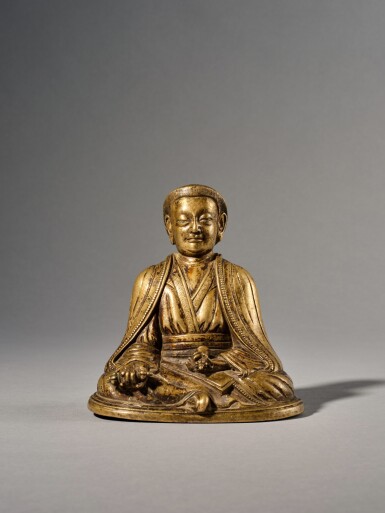Indian and Himalayan Art, including Masterpieces from the Nyingjei Lam Collection
Indian and Himalayan Art, including Masterpieces from the Nyingjei Lam Collection

Masterpieces of Tibetan art from the Nyingjei Lam Collection
A copper alloy figure of Marpa, Tibet, 13th / 14th century
Auction Closed
March 21, 04:25 PM GMT
Estimate
200,000 - 250,000 USD
Lot Details
Description
A copper alloy figure of Marpa
Tibet, 13th / 14th century
西藏 十三 / 十四世紀 銅瑪爾巴像
Himalayan Art Resources item no. 68487.
HAR編號68487
Height 5¼ in., 13.3cm.
David Weldon and Jane Casey Singer, The Sculptural Heritage of Tibet: Buddhist Art in the Nyingjei Lam Collection, London, 1999, pl. 38.
The Tibetan guru Marpa (1012-1097) is one of the seminal protagonists in the history of Tibetan Buddhism during the period described by Tibetans as the Chidar, or Later Diffusion of the Faith between the tenth and twelfth centuries. Marpa mastered Sanskrit, sought Buddhist teaching in India, and became known as a great Lotsawa, the title bestowed on Tibetan translators of the ancient Indian texts. He remained a layman although he was highly regarded as a teacher, and his disciples went on to found the Kagyu order of Tibetan Buddhism. He was a contemporary of the Indian teacher Atisha (982-1054), another seminal character in the early history of Tibetan Buddhism. Marpa was known as a strict disciplinarian, suggested here in the stern expression fixed on the guru’s face. The master’s lay status is reflected in the absence of monastic apparel and his relaxed seated posture, with a booted foot protruding from beneath a long-sleeved garment secured at the waist by a thick sash, and a heavy cloak draped over the shoulders and enveloping his legs. His mastery of Buddhism however is revealed by the important ritual implements he holds, a vajra in the outstretched right hand and the ghanta in the left. Marpa is identified by his distinctive coiffure rising up sharply from the forehead with a whorl of hair at the crown, cf. the hair of a bronze portrait of Marpa identified by inscription in the Metropolitan Museum of Art (acc. no. 1995.176). Portraits of the master often show him with both hands extended forward in the earth-touching mudra, or in the teaching gesture, while the rarer iconography of the Nyingjei Lam example with vajra and ghanta is recorded in the Asta-sahasrika Pantheon, see Lokesh Chandra, Buddhist Iconography, New Delhi, 1991, fig. 1330.
The style of Marpa’s robes, the folds of cloth, the minimal decoration on the hems, invite comparison with pre-fifteenth century Tibetan bronze portraits of monks and teachers which include a thirteenth century figure of Marpa in the Jokhang, see Ulrich von Schroeder, Buddhist Sculptures in Tibet, Hong Kong, 2001, vol. II, pls 320A-E . The Nyingjei Lam Marpa is likely to date to at least the fourteenth century, predating the popular styles in the fifteenth and later centuries such as a series of Sakya masters at Ngor monastery, ibid., pls 333A-E. This rare portrait of one of Tibet’s most revered teachers is thus among the earliest known examples together with the Jokhang Marpa, and certainly one of the finest and most expressive.
西藏上師瑪爾巴(1012-1097年)乃十至十二世紀間藏傳佛教之重要推手,精通梵文,赴印度學習佛法,與印度高僧阿底峽(982-1054年)為同期,依瑪爾巴之教導,弟子門徒創立噶舉派。據傳,瑪爾巴嚴守戒律,遂見此像莊嚴表情,著靴、長袖寬帶、肩披厚袍,直至腿踝,觀其衣著可知瑪爾巴之瑜珈士身分,非出家眾。右手持金剛杵,左手金剛鈴,如此重要法器,可見其佛教成就。瑪爾巴上師像特徵為額際上梳,頭頂髮旋,參考紐約大都會藝術博物館藏瑪爾巴造像(館藏編號:1995.176),其上銘文確認此像身分。
本品衣袍風格,衣褶描寫、邊沿裝飾素雅,可對比十五世紀以前之祖師造像,如大昭寺藏一尊十三世紀瑪爾巴像,錄於 Ulrich von Schroeder,《Buddhist Sculptures in Tibet》,香港,2001年,卷2,圖版 320A-E。菩薩道珍藏此像,應最晚造於十四世紀,尚無十五世紀之後盛行之上師像風格,如俄爾寺薩迦祖師像,同上,圖版 333A-E。與大昭寺瑪爾巴像相類,本像屬藏傳佛教藝術中最早之上師像,亦是最細膩生動者。
